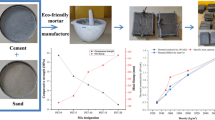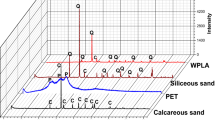Abstract
The massive amount of plastic production inevitably leads to huge levels of pollution and, consequently, is threatening the environment and people’s safety. To reduce plastic pollution, research on new ways of reutilization of plastic waste is an open issue nowadays. The main purpose of this work is to evaluate the feasibility of the incorporation of ground polyethylene terephthalate (PET) waste in mortars by comparing the values obtained of mechanical resistance (after 28 days), capillarity water absorption coefficients and thermal conductivity coefficients in an experimental program with the standard values. Mortars prototypes produced at ratios of 1:4 and 1:3 in weight, with partial replacement of the aggregate by PET residuals in different percentages (0, 5 and 10%) were considered. The obtained results show a decrease in mechanical resistance of mortars which was inversely proportional to the use of PET residues in the mixture. An increase in resistance of water absorption by capillary action and a decrease in thermal conductivity was also identified. These results indicate that the replacement of natural aggregates by PET residues in mortars is an interesting option to be considered for the production of a new and environmentally friendly material.













Similar content being viewed by others
References
Unite Nations, Report: The State of Plastics—World Environment Day Outlook 2018. https://www.unenvironment.org/resources/report/state-plastics-world-environment-day-outlook-2018. Accessed 3 Apr 2020
Remadnia A, Dheilly RM, Laidoudi B, Quéneudec M (2009) Use of animal proteins as foaming agent in cementitious concrete composites manufactured with recycled PET aggregates. Constr Build Mater 23(10):3118–3123. https://doi.org/10.1016/j.conbuildmat.2009.06.027 (ISSN 09500618)
Choi Y, Moon D, Chung J, Cho S (2005) Effects of waste PET bottles aggregate on the properties of concrete. Cem Concr Res 35(4):776–781. https://doi.org/10.1016/j.cemconres.2004.05.014 (ISSN 00088846)
Canellas SS, D’ABREU JC (2005) Reciclagem de PET, visando a substituição de agregado miúdo em argamassa, In: XXI Encontro Nacional de Tratamento de Minérios e Metalurgia Extrativa, Natal, RN. Brasil
Ge Z, Sun R, Zhang K, Gao Z, Li P (2013) Physical and mechanical properties of mortar using waste Polyethylene Terephthalate bottles. Constr Build Mater 44:81–86. https://doi.org/10.1016/j.conbuildmat.2013.02.073
Hannawi K, Kamali-Bernard S, Prince W (2010) Physical and mechanical properties of mortars containing PET and PC waste aggregates. Waste Manage 30(11):2312–2320. https://doi.org/10.1016/j.wasman.2010.03.028 (ISSN 0956053X)
Pereira E, Junior AL, Fineza A (2017) Optimization of mechanical properties in concrete reinforced with fibers from solid urban wastes (PET bottles) to produce ecological concrete. Constr Build Mat 149:837–848. https://doi.org/10.1016/j.conbuildmat.2017.05.148
Monteiro LLC, Garcia ML (2018) Uso de Resíduos de Embalagens PET em Argamassas. Coimbra. 3º Congresso Luso-Brasileiro (Article CLB-MCS 2018)
Oliveira MR, Garcia ML, Castro ACM, Silva TN (2019) Mortar with PET—preliminary results. Energy Rep. https://doi.org/10.1016/j.egyr.2019.11.005
Hannawi K, Prince W, Kamali-Bernard S (2010) Effect of Thermoplastic aggregates incorporation on physical, mechanical and transfer behaviour of cementitious materials. Waste Biomass Valorization 1:251–259. https://doi.org/10.1007/s12649-010-9021-y
Marzouk Y, Dheilly RM, Queneudec M (2007) Valorization of post-consumer waste plastic in cementitious concrete composite. Waste Manage 27:310–318
Wang R, Meyer C (2012) Performance of cement mortar made with recycled high impact polystyrene. Cement Concr Compos 34:975–981. https://doi.org/10.1016/j.cemconcomp.2012.06.014
Corinaldesi V, Mazzoli A, Moriconi G (2011) Mechanical behaviour and thermal conductivity of mortars with waste plastic particles. Key Eng Mater. https://doi.org/10.4028/www.scientific.net/KEM.466.115
Benosman A, Mouli M, Taibi H, Belbachir M, Senhadji Y, Bahlouli I, Houivet D (2017) The chemical, mechanical and thermal properties of pet—mortar composites containing waste PET. Environ Eng Manag Journal 16:1489–1505. https://doi.org/10.30638/eemj.2017.162
RILEM TC 116-PCD (1999) Permeability of concrete as a criterion of its durability. Mater Struct 32:174–179
Acknowledgments
The authors declare that this is an extension of the work presented at ICEER2019 and published in Energy Reports. The authors gratefully acknowledge the support of the CERENA (strategic project FCT-UIDB/04028/2020).
Author information
Authors and Affiliations
Corresponding author
Additional information
Publisher's Note
Springer Nature remains neutral with regard to jurisdictional claims in published maps and institutional affiliations.
Rights and permissions
About this article
Cite this article
da Luz Garcia, M., Oliveira, M.R., Silva, T.N. et al. Performance of mortars with PET. J Mater Cycles Waste Manag 23, 699–706 (2021). https://doi.org/10.1007/s10163-020-01160-w
Received:
Accepted:
Published:
Issue Date:
DOI: https://doi.org/10.1007/s10163-020-01160-w




